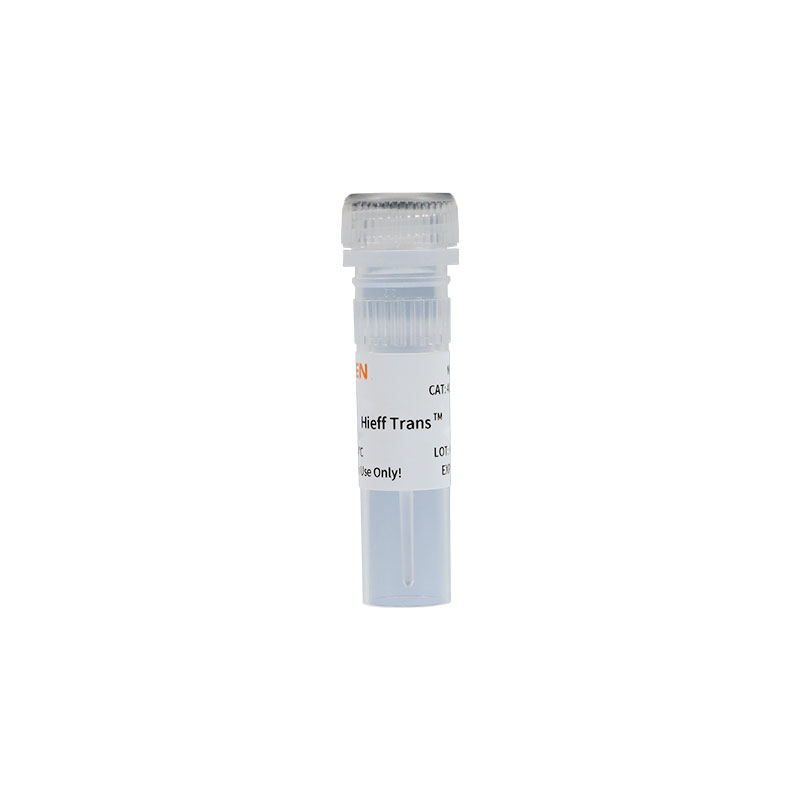Hieff Trans™ Suspension Cell-Free Liposomal Transfection Reagent
Product Description
Hieff Trans™ Suspension Cell-Specific Liposome Nucleic Acid Transfection Reagent is a cationic liposomal transfection reagent optimized for the transfection of suspension cells and is suitable for the transfection of DNA, RNA, and oligonucleotides. High transfection efficiency for most eukaryotic cells.
Hieff Trans™ Suspension Cell Specific Liposomal Nucleic Acid Transfection Reagents are supplied in sterile liquid form.
Shipping and Storage
The product is shipped with ice packs and can be stored at 2-8ºC for one year. Do not freeze!
Cautions
1) To obtain the best transfection efficiency, please dilute Hieff Trans™ Suspension Cell-Free Liposomal Transfection Reagent (hereinafter referred to as Hieff Trans™) with serum-free medium (such as OPTI-MEM I medium), and then mix it with DNA or RNA. Do mix.
2) The use of high-quality DNA or RNA helps to obtain higher transfection efficiency. Be sure to ensure the high purity and sterility of the plasmid, and completely remove the phenol and high salt that may remain during the plasmid extraction process, because the above phenols will Damage to cells and high salt interferes with "Hieff Trans™-complex" formation. The endotoxin in the plasmid is also the enemy of transfection and must be removed.
3) Antibiotics should not be added to the medium during transfection.
4) Cationic liposomes should be stored at 4°C, and care should be taken to avoid repeated repeated opening of the cap for a long time, as it may cause liposome oxidation and affect the transfection efficiency.
5) The DNA concentration and the amount of cationic liposome reagents need to be optimized for maximum transfection efficiency. The ratio of DNA to Hieff Trans™, usually 1:2 or 1:3 is recommended.
6) For research use only!
Recommended transfection conditions (take 293 suspension culture cells and plasmid DNA transfection as an example)
Final transfection volume: 30 mL
The number of transfected cells: 3×107 cells (final cell density: 1×106 cells/mL). Before transfection, it is necessary to ensure that the cells are healthy and the cell viability is >90%.
Plasmid DNA amount: 20–40 μg (typically use 30 μg)
Transfection reagent volume: 40–80 μL (typically use 60 μL). Use 2 μL Hieff Trans™ per 1 μg of plasmid DNA transfected.
Instructions (293 suspension culture cells)
Use the following steps to transfect 293 cells in a 30 mL total system. Do not add antibiotics to the growth medium during the transfection process, otherwise the transfection efficiency will be reduced. Please set both positive and negative control groups (no DNA, no Hieff Trans™) during transfection.
[Note] For other total culture systems, scale up or down the amount of each component.
1. On the day of transfection, before preparing the complex, prepare the required amount of cells for transfection [see the recommended transfection conditions above, that is, add 3 × 107 cells to 28 mL of growth medium, and determine cell viability and cell viability by trypan blue exclusion method. Measure the amount of cell agglomeration. Vortex vigorously for 45 s to break up cell clumps and measure total cell mass with a counter. Cell viability needs to be >90%.
[Note] For optimal efficiency, ensure a single-cell suspension.
2. Prepare the Hieff Trans™-DNA complex as follows,
1) Dilute 30 μg of plasmid DNA with serum-free medium (such as OPTI-MEM I) to a final volume of 1 mL;
2) Dilute 60 μL Hieff Trans™ with serum-free medium (such as OPTI-MEM I) to make a final volume of 1 mL; mix gently and incubate at room temperature for 5 mins;
[Note] Incubation for too long will reduce efficiency.
3) After 5 mins of incubation, add the diluted plasmid DNA to the diluted Hieff Trans™ to make a total volume of 2 mL. Mix gently.
4) Incubate at room temperature for 20-30 mins to allow DNA-Hieff Trans™ complex to form. The solution may be cloudy at this point, but it will not affect transfection.
[Note] DNA-liposome complexes are stable at room temperature for at least 5 h.
3. After the incubation is complete, add 2 mL of DNA-Hieff Trans™ complex to 28 mL of growth medium containing 293 cells in suspension so that the final cell density is approximately 1 x 106 cells/mL. For negative controls, replace with 2 mL of serum-free medium such as OPTI-MEM I.
4. Incubate at 37°C, 8% CO2 on an orbital shaker at 125 rpm until transgene expression analysis, without removing complexes or changing medium. However, it may be necessary to change the growth medium after 4-6 h without reducing transfection activity.
Hieff Trans™ Suspension Cell-Free Liposomal Transfection Reagent FAQ
(1) Q: Can serum be present when preparing nucleic acid transfection reagent complex?
A: The presence of serum will affect the formation of liposomes. It is recommended to use serum-free medium (usually MEM medium) when preparing nucleic acid transfection reagent complexes.
(2) Q: Can the transfection reagent be frozen?
A: No. This reagent must be stored at 4 ℃, and care should be taken to avoid repeatedly opening the cap for a long time, as long-term opening of the cap will cause liposome oxidation and affect the transfection efficiency.
[1] Cheng Y, Liu Y, Shi S, et al. Functional Characterization of Duck STING in IFN-β Induction and Anti-H9N2 Avian Influenza Viruses Infections. Front Immunol. 2019;10:2224. Published 2019 Sep 18. doi:10.3389/fimmu.2019.02224(IF:4.716)
[2] Li J, Peng S, Zhong L, et al. Identification and validation of a regulatory mutation upstream of the BMP2 gene associated with carcass length in pigs. Genet Sel Evol. 2021;53(1):94. Published 2021 Dec 14. doi:10.1186/s12711-021-00689-0(IF:4.297)
Catalog No.:*
Name*
phone Number:*
Lot:*
Email*
Country:*
Company/Institute:*

